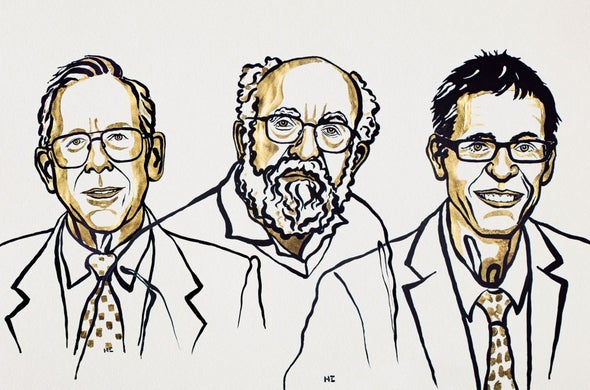(单词翻译:单击)
听力文本
This is Scientific American's 60-second Science, I'm Steve Mirsky.
"This year's Nobel laureates in physics have painted a picture of a universe far stranger and more wonderful than we ever could have imagined."
Theoretical physicist Ulf Danielsson from Uppsala University. Here's the announcement this morning from Göran Hansson of the Nobel Assembly at the Karolinska Institute.
"The Royal Swedish Academy of Sciences has today decided to award the 2019 Nobel Prize in Physics with one half to James Peebles for theoretical discoveries in physical cosmology and the other half, jointly, to Michel Mayor and Didier Queloz for the discovery of an exoplanet orbiting a solar-type star."
"James Peebles was born in 1935 in Canada, in Manitoba. And he has had his career largely at Princeton University where he is today the Albert Einstein Professor of Science. Michel Mayor was born in 1942 in Lausanne in Switzerland. He is emeritus professor of astronomy at the University of Geneva ... the city in Switzerland. Didier Queloz, finally, was born in 1966, and is also from Switzerland. He is currently professor or astrophysics both at the University of Geneva and at the Cavendish Laboratory of the University of Cambridge in the United Kingdom."

Back to Ulf Danielsson.
"At the time of its discovery in the mid-1960s, James Peebles realized the importance of cosmic radiation. Through his work and new ways to observe and measure our universe, cosmology evolved into a science of precision, based on the mathematical foundation."
"Michel Mayor and Didier Queloz—they are awarded the Nobel Prize in Physics for the discovery of a planet in orbit around another sun. They couldn't see the planet directly, so they had to use other methods. When a planet is orbiting a star, the star wobbles back and forth. The effect is tiny, and you need care and ingenuity if you want to detect it. Through the study of these exoplanets, we will learn more about the physics of how planets form and evolve and get a new perspective on our planetary home."
For an in-depth listen about the 2019 Nobel Prize in Physics, look for the Scientific American Science Talk podcast later today.
For Scientific American's 60-second Science. I'm Steve Mirsky.
参考译文
这里是科学美国人——60秒科学系列,我是史蒂夫·米尔斯基。
“今年的诺贝尔物理学奖获奖者所描述的宇宙图景比我们曾想象的要更加奇妙和精彩。”
乌普萨拉大学的理论物理学家乌尔夫·丹尼尔森说到。今天上午,卡罗林斯卡学院诺贝尔大会的戈兰·汉森宣布了获奖者。
“瑞典皇家科学院今天决定将2019年诺贝尔物理学奖一半授予詹姆斯·皮布尔斯,以表彰他在物理宇宙学的理论发现,另一半共同授予米歇尔·马约尔和迪迪埃·奎洛兹,以表彰他们发现了一颗围绕类太阳恒星运行的系外行星。”
“詹姆斯·皮布尔斯1935年出生于加拿大曼尼托巴省。他大部分职业生涯在普林斯顿大学度过,是当今科学界的阿尔伯特·爱因斯坦教授。米歇尔·马约尔1942年出生于瑞士洛桑。他是瑞士日内瓦大学的天文学名誉退休教授。最后一名获奖者迪迪埃·奎洛兹出生于1966年,同样来自瑞士。他目前是日内瓦大学和英国剑桥大学卡文迪什实验室的天文物理学教授。”
下面继续来听乌尔夫·丹尼尔森的介绍。
“在宇宙辐射于上世纪60年代中期被发现时,詹姆斯·皮布尔斯就意识到了其重要性。通过他的研究以及观察和测量宇宙的新方法,宇宙学进化为以数学为基础的精密科学。”
“米歇尔·马约尔和迪迪埃·奎洛兹被授予诺贝尔物理学奖,以表彰他们发现了围绕另一个太阳旋转的行星。他们无法直接看到那颗行星,因此他们不得不使用其他方法。当行星围绕恒星旋转时,恒星会来回晃动。这种效应非常微小,需要仔细和创造方法才能探测到。通过对这些系外行星的研究,我们将进一步了解行星形成和进化的物理学知识,同时对我们的行星家园有一个新的认知。”
若想深入了解2019年诺贝尔物理学奖,请收听今天晚些时候播出的《科学美国人》“科学对话”播客。
谢谢大家收听科学美国人——60秒科学。我是史蒂夫·米尔斯基。
译文为可可英语翻译,未经授权请勿转载!
重点讲解
重点讲解:
1. decide to do sth. 决定,拿定主意(做);
Students may decide to seek tutorial guidance.
学生可以决定寻求导师指导。
2. be based on 以…为基础;
The treaty was based on a bargain between the French and German governments.
这个条约是以法国和德国政府之间的一个协议为基础的。
3. back and forth 来回;往返;
I could see the branches of the trees moving back and forth.
我能看到树枝来回摇摆。
4. look for 寻找;
Look for software that's flexible enough for a range of abilities.
寻找功能多、适用性强的软件。


